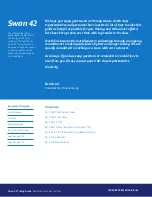
2
Swan 42 Tuning Guide
Solutions for today’s sailors
Part 2: Headstay (continued)
Use the tuning matrix to adjust according
to wind conditions. The base setting is plus
6 from max long.
If you are currently are using the Reckmann
headstay, please request a Reckmann
Headstay Tuning Matrix from your North
representative.
Adjust headstay length until the distance
between the sheer line and mark “C”
(Fig. 3) is 1.735m. This is the max long
headstay setting. The BASE setting is
1.725m, which is 6 turns from max.
Part 3: Trim
Note headsail trim reference marks on
spreaders in Fig. 4 above.
On the top spreader – mark the underside
of the spreader exactly at the beginning of
the spreader taper “A”.
On the bottom spreader – mark the
distance exactly half way between the sail
track and the spreader tip = 93.5cm “B” .
Note sheeting angle reference marks in Fig.
5 above.
Using a metric tape measure, apply marks
to the deck to for jib inhaul positions.
• 0.70 is the jib track.
• 80 is 792mm from centerline.
• 7.500 is 752mm from centerline.
• 7.000 is 692mm from
centerline – high point and flat water.
• 6.50 is 642mm from centerline – easy
target speed and very flat water only.
Part 4: Essential Items to
Tune a Swan 42
• Vernier calipers to measure
turnbuckle thread distance.
• Lanacote to apply to turnbuckle
threads to prevent thread damage.
• Excel spreadsheet to record fast
settings as they develop.
• 30 m steel metric tape measure.
• Loos Gauge RT-10 for upper diagonal
shroud (D2) and RT-11 for upper
shroud and lower diagonal (D1).
Two Cool, Go-Fast Tips
The mainsheet blocks can chafe the
mainsheet unless there is a 10cm loop
attached “E” (Fig. 6). A good boathook with
length expandability is a must. Here’s a
simple storage location too “F” (Fig. 6).
Fig.3
Fig. 4
Fig. 6
Fig. 5
C
A
F
B
E
Yacht Centerline
Fig.3: distance between the sheer line
and mark “C”
Fig.4: headsail trim reference marks
Fig. 5: Sheeting angle reference marks
Fig. 6 Mainsheet block and boat hook



























